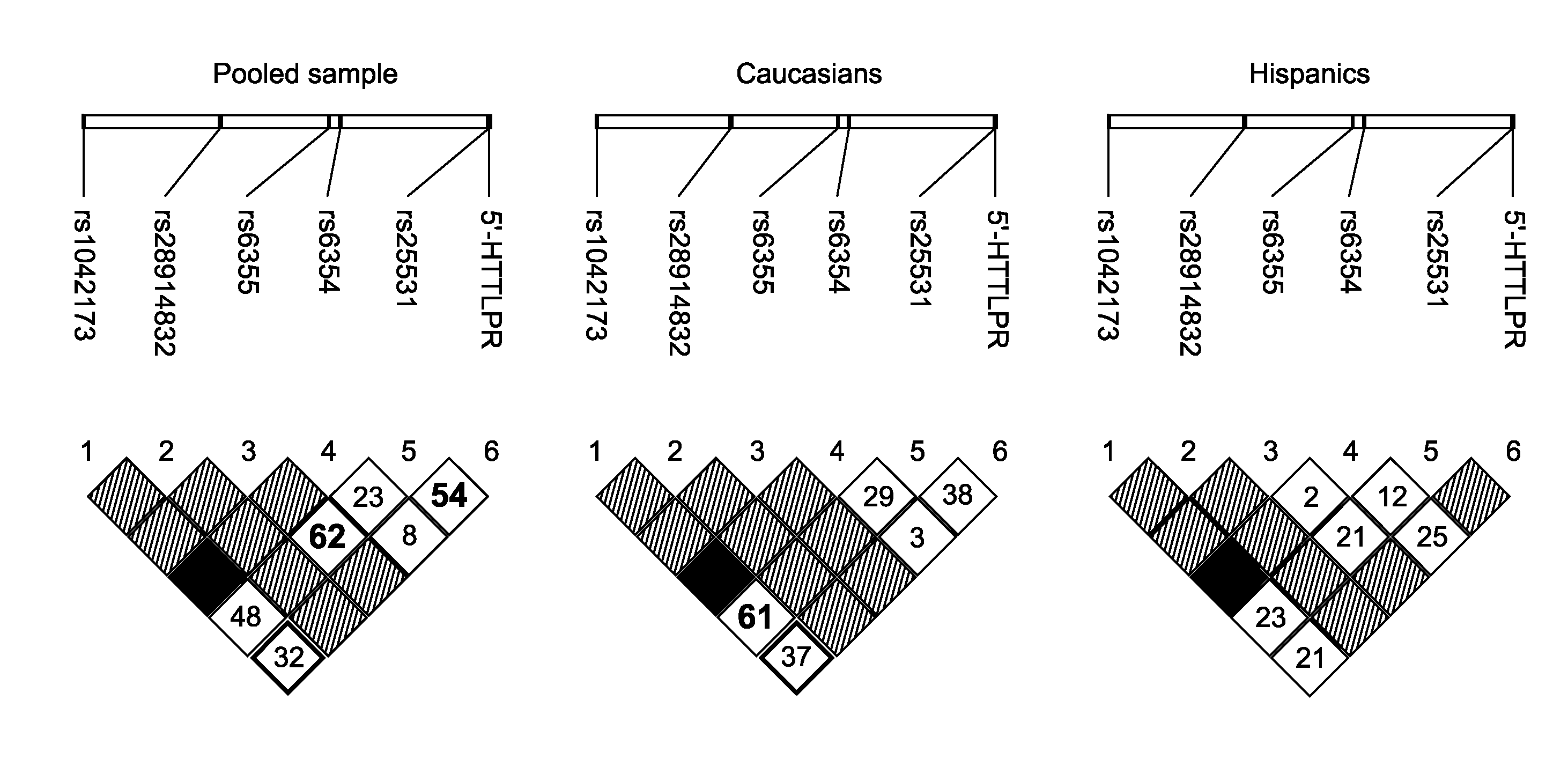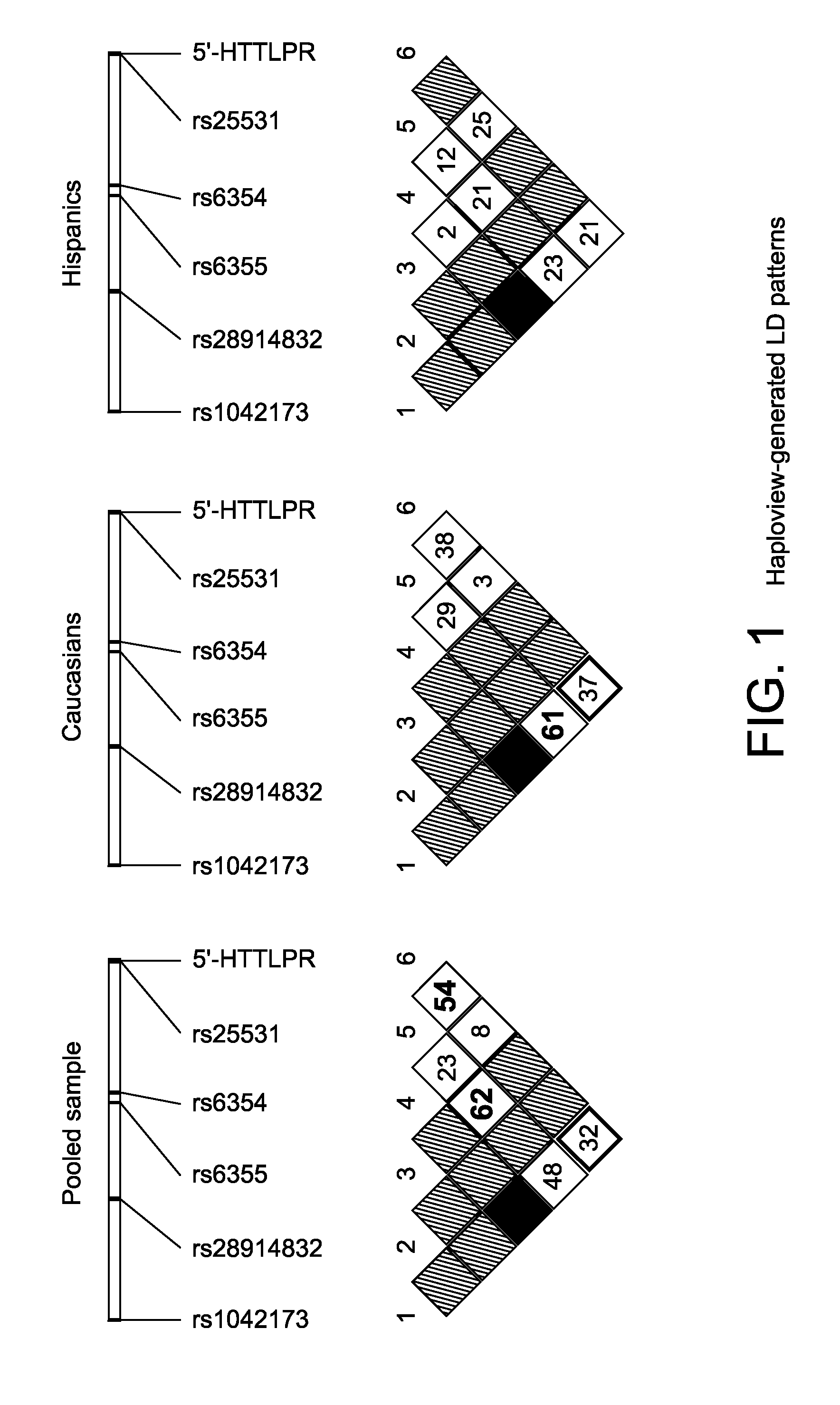Serotonin transporter gene and treament of alcoholism
a transporter and serotonin technology, applied in the field of serotonin transporter, alcohol related diseases and disorders, can solve the problems of inability to demonstrate clinical efficacy, more rigorous, well controlled, etc., and achieve the effects of reducing the average level of alcohol consumption, improving the physical or psychological sequelae, and increasing the abstinence rate of subjects
- Summary
- Abstract
- Description
- Claims
- Application Information
AI Technical Summary
Benefits of technology
Problems solved by technology
Method used
Image
Examples
embodiments
[0217]The number of serotonin transporter protein molecules in cells is affected by the amount of mature (secondary) serotonin transporter mRNA molecules expressed in that cell. The expression levels of mRNA are controlled by the 5′-HTTLPR and 3′-UTR of the SLC6A4 gene via two different mechanisms. The 5′-HTTLPR region controls the transcription rate of SLC6A4 (Heils et al., (1996) J. Neurochem. 66:2621-2624), while rs1042173 SNP in the 3′-UTR of SLC6A4 affects mature mRNA levels via post-transcriptional mechanisms (Battersby et al., (1999), J. Neurochem. 72:1384-1388; Beaudoing et al., (2000), Genome Res 10:1001-1010; Chen et al., (2006), Nat. Genet. 38:1452-145).
[0218]The 5′-HTTLPR is found to harbor several binding sites for different transcription factor molecules necessary for the regulation of transcription initiation (Hu et al., (2005), Alcohol Clin. Exp. Res. 29:8-16). Therefore, the number of nascent (primary) mRNA copies transcribed by the SLC6A4 gene and the subsequent ma...
example 1
Correlation of a Functional Polymorphism in the 3′UTR of the Serotonin Transporter Gene SLC6A4 and its Association with Drinking Activity
[0450]It was determined whether allelic variation at a single nucleotide polymorphism (SNP) within a putative polyadenylation signal for a commonly used 3′ polyadenylation site G2651T SNP (National Center for Biotechnology Information reference ID #rs1042173) of SLC6A4, the serotonin transporter gene, is associated with differences in the severity of drinking among treatment-seeking alcoholics. To determine the functional significance of the G2651T / rs1042173 SNP, we examined whether allelic variation at this site was associated with quantifiable changes in mRNA expression level and 5-HTT protein expression. The human serotonin transporter gene (SLC6A4) is found at position 17q11.1-q12 of chromosome 17. G2651T / rs1042173 is in exon 15 position 25,549,137. Additionally, the 5-HTTLPR is in the promoter at chromosome position 25,588,500. The sequence of...
example 2
[0553]1. Johnson, B. A. and N. Ait-Daoud, Psychopharmacology, 2000. 149: p. 327-344.[0554]2. LeMarquand et al., Biological Psychiatry, 1994. 36: p. 326-337.[0555]3. LeMarquandet al., American Journal of Psychiatry, 1999. 156: p. 1771-1779.[0556]4. Stoltenberg, S. F., Alcoholism: Clin. Exp. Res., 2003. 27: p. 1853-1859.[0557]5. Linnoila et al., Life Sciences, 1983. 33: p. 2609-2614.[0558]6. Fils-Aime, M. L., et al., Archives of General Psychiatry, 1996. 53(3): p. 211-216.[0559]7. Cloninger, C., Science, 1987. 236: p. 410-416.[0560]8. Virkkunen et al., Archives of General Psychiatry, 1987. 44: p. 241-247.[0561]9. Virkkunen et al., Archives of General Psychiatry, 1996. 53: p. 523-529.[0562]10. Swann et al., Psychopharmacology, 1999. 143: p. 380-384.[0563]11. Grunbaum, J. A., et al., Morb. Mort. Wkly Rpt., Surveil. Sum. 2002. 51(4): p. 1-62.[0564]12. McBride, et al., Critical Reviews in Neurobiology, 1998. 12: p. 339-369.[0565]13 Virkkunen, et al., Journal of Psychiatry and ...
PUM
| Property | Measurement | Unit |
|---|---|---|
| pH | aaaaa | aaaaa |
| body weights | aaaaa | aaaaa |
| body weights | aaaaa | aaaaa |
Abstract
Description
Claims
Application Information
 Login to View More
Login to View More - R&D
- Intellectual Property
- Life Sciences
- Materials
- Tech Scout
- Unparalleled Data Quality
- Higher Quality Content
- 60% Fewer Hallucinations
Browse by: Latest US Patents, China's latest patents, Technical Efficacy Thesaurus, Application Domain, Technology Topic, Popular Technical Reports.
© 2025 PatSnap. All rights reserved.Legal|Privacy policy|Modern Slavery Act Transparency Statement|Sitemap|About US| Contact US: help@patsnap.com



